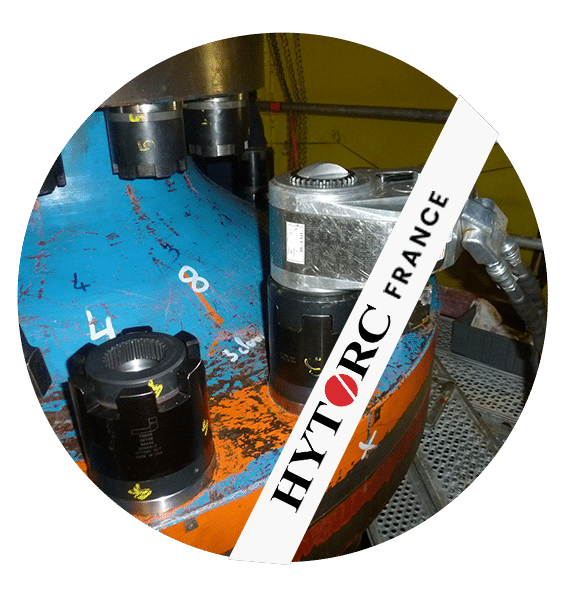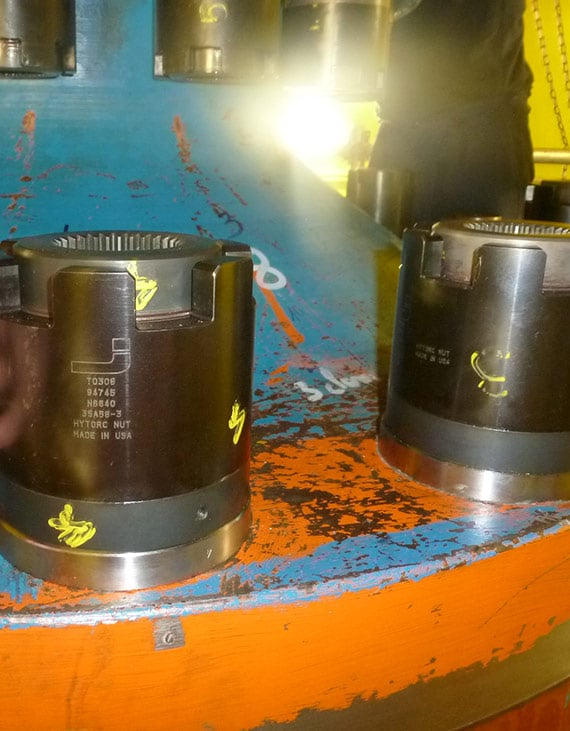A HYTORC NUT tensioning nut is a mechanical tensioner which allows to tighten a bolt in pure tension with a torque tool. This nut is made in 3 pieces to protect the bolted assembly from friction and wear.
A ring at the base ensures contact without movement on the bearing surface, a threaded insert accompanies the longitudinal stroke of the threaded rod without rotation and the force is transmitted by an external sleeve which only rubs on the other 2 parts.
There are 3 types ofHYTORC NUT tensioning nuts according to the needs: type TN when the threaded rod does not protrude from the nut, type CN when the threaded rod protrudes from the nut or type SN when the nut has to be driven by a hydraulic wrench.

To be able to tighten a bolted assembly in tension quickly and with great precision, the HYTORC NUT tensioning nut is your ideal ally.
It combines the advantages of tensioner tightening, which does not wear out bearing surfaces and provides effort without parasitic stress, with the benefits of torque tightening tools, which set up very quickly and easily without giving rise to mechanical relaxation on removal.
The Hydraulic wrenches with square driver or torque screwdrivers are equipped with a driver that drives the outer sleeve and takes its reaction on the threaded insert, preventing the threaded shank from rotating and therefore from undergoing any torsional stress.
With a hydraulic eye wrench fitted with a reaction plate on the side, the link cassette drives the sleeve and takes without reaction on the base ring to obtain the same tightening characteristics.

This mechanical tensioner is driven by a torque tightening tool, so the operation is incomparably faster than a multi-screw tensioner or traditional hydraulic tensioning tightening.
As with conventional torque tightening, the hydraulic wrench or torque screwdriver sits on the bolt and applies its force directly and can move on to the next nut without tedious set-up.
.
Moreover, the tool is freed from its reaction arm with the use of the driver so there is no longer the issue of a fixed, solid fulcrum to find for tightening each bolt which saves time and helps operator productivity with increased safety.
The applied tension force is not subject to relaxation at the end of tightening which means that the tightening tool can be adjusted directly to the required tension level without any surplus that could reduce the final tightening accuracy of the assembly.
The internal lubrication between the 3 parts of the nut is controlled by HYTORC, and the nuts are supplied with a correspondence chart between the torque applied (or the pressure to be set for a hydraulic wrench) and the resulting tension, as there is no external friction during tightening.
Tensioning is progressive and uniform.
This HYTORC NUT tensioning nut is the most widely used because it replaces a conventional nut with a reduced footprint.
The outside diameter is approximately equal to the flat dimension of the hex nut it replaces. It’s also a little higher to encompass the threaded rod end.
The hexagonal nut is often used to replace the hexagonal nut.
It is often found implanted on turbine housings, as the HYTORC NUT TN tensioning nut is a good solution to the seizing problems encountered on devices.
It is tightened and loosened by hydraulic wrenches with square drive or pneumatically or electrically powered torque wrenches.

The HYTORC NUT type CN is designed to replace conventional nuts on applications where the threaded rod protrudes more than normal.
The height of the HYTORC NUT tensioning nut is greater than a conventional nut, but the threaded rod can protrude beyond its top face without preventing its use. In terms of outside diameter, it is equivalent to the dimension on flats of the conventional nut it replaces.
This nut is operated by tools with a conducting square.